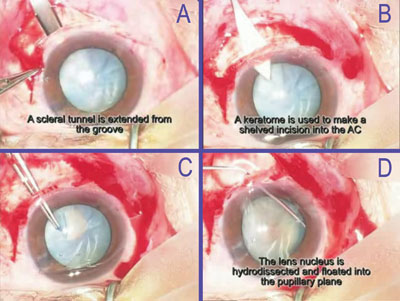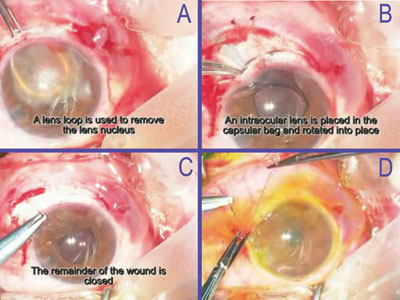Surgeons can find utility in evolved version of manual extracapsular cataract surgery
The technique is valuable in cases of mature cataracts as well as in challenging cases in which phacoemulsification is riskier or not possible.
Click Here to Manage Email Alerts
 Uday Devgan |
Phacoemulsification has replaced manual extracapsular cataract extraction, or ECCE, in many countries because it offers smaller incisions and often faster recovery in a less invasive procedure. But there are still cases in which a manual extracapsular cataract surgery may be the best choice.
Over the course of the last decade, I have made sure that all of the surgeons who complete their residency training with me learn ECCE surgery. It is not the ECCE that I learned years ago, but an evolved version.
The most advanced technique of ECCE surgery that I have seen is the small-incision cataract surgery (SICS) technique that I learned in India years ago. SICS combines some of the benefits of phacoemulsification, such as a shelved incision and a capsulorrhexis, and can be performed with basic instrumentation.
In skilled hands, SICS can be performed in just minutes with a rapid recovery of vision. In eyes with dense, brunescent or mature cataracts, SICS can be even safer to the corneal endothelium than phacoemulsification. I have seen a skilled surgeon in India perform more than 50 SICS procedures in just a few hours. Clearly, we can learn a lot from the SICS procedure and bring these advances to our ECCE surgery.
Surgical technique
Under retrobulbar or peribulbar anesthesia, the eye is draped and prepped in the standard manner, including use of povidone iodine for antisepsis. A paracentesis is made into the anterior chamber, and trypan blue dye can be used to stain the anterior lens capsule. Viscoelastic is injected into the anterior chamber to protect the corneal endothelium and pressurize the eye.
A conjunctival peritomy is performed for a few clock hours in order to expose the sclera, where a half-depth groove is performed. Electrocautery is used to achieve hemostasis, and Tenon’s layer is dissected away. A shelved scleral lip is extended along the groove, and then a keratome is used to enter the anterior chamber. This shelved incision is important to allow for better sealing of the wound.
In the past, the use of corneoscleral scissors was common in ECCE surgery, but they produce an incision that tends not to seal well. Skilled SICS surgeons often perform their surgical technique without the use of sutures, even for incisions that extend a few clock hours. This is because the shelved nature allows for a watertight closure due to the increased surface area of the apposed tissues.
 (A) After a conjunctival peritomy is performed, a half-depth scleral groove is created, then (B) a keratome is used to enter the anterior chamber via a shelved incision. A continuous, curvilinear capsulorrhexis is created (C), and then the lens nucleus is hydrodissected and brought into the pupillary plane (D). Images: Devgan U |
 A lens loop is used to remove the lens nucleus (A), the cortical material is removed (not shown), and then the IOL is placed into the capsular bag, which is filled with viscoelastic (B). Sutures are used to close the incision in a watertight manner (C), and then the conjunctiva is closed and fluorescein dye is used to confirm sealing of the incision (D). |
A capsulorrhexis of at least 5 mm in diameter is performed, often under the enhanced visualization of trypan blue dye. It is important to have a sufficiently large capsulorrhexis so that the nucleus can be prolapsed out of the capsular bag using balanced salt solution or a dispersive viscoelastic. The scleral incision is extended in the form of a trapezoidal tunnel, with an internal opening of approximately 10 mm and an external opening of about 7 mm. A paracentesis allows access to further inject viscoelastic to pressurize the eye to facilitate delivery of the nucleus.
The nucleus can also be divided into halves or even smaller pieces in the anterior chamber, which would allow for an even smaller scleral incision. With the nucleus in the anterior chamber and under the protection of viscoelastic, the nucleus can be speared via the scleral incision while the chopper is used via the paracentesis to fracture and subdivide the cataract.
Once the nucleus is removed, it is important to remove the lens cortical material. This can be done with an irrigation and aspiration handpiece, a Simcoe canula system or even balanced salt solution to simply irrigate the capsular bag clean in cases of mature cataracts in which the cortex is already liquefied.
The capsular bag is filled with a cohesive viscoelastic, and the IOL is inserted into the capsular bag. Because there is already a large incision in the eye, it is unnecessary to use a foldable acrylic or silicone IOL because a rigid PMMA lens can easily be inserted. The cohesive viscoelastic is removed from the eye, and the incision is closed, typically with 10-0 nylon sutures. It is important to keep approximately the same tension on all of the sutures in order to ensure that the incision is closed evenly and is watertight. The suture knots are rotated into the sclera, and then fluorescein is used to check the incision for any leakage. The conjunctiva is closed using Vicryl sutures or electrocautery, and the eye is medicated with antibiotics and anti-inflammatories.
The postoperative course for these patients is excellent, with a quick recovery of vision. Due to the larger incision size, there can be flattening at that corneal meridian with resultant astigmatism that may progress in the future. ECCE surgery is a valuable technique in cases of mature cataracts as well as in challenging cases in which phacoemulsification is riskier or not possible. I encourage all beginning surgeons to learn this technique and add it to their core set of surgical skills.
I would like to acknowledge Alex Yuan, MD, PhD, who performed the excellent surgical procedure shown here as a first-year resident under my guidance.

- Uday Devgan, MD, FACS, is in private practice at Devgan Eye Surgery in Los Angeles, Beverly Hills and Newport Beach, Calif. He is also chief of ophthalmology at Olive View UCLA Medical Center and associate clinical professor at the UCLA School of Medicine. He can be reached at 11600 Wilshire Blvd., Suite 200, Los Angeles, CA 90025; 800-337-1969; fax: 310-388-3028; e-mail: devgan@gmail.com; website: www.devganeye.com.
